
1. Project Name: New Mineral Discovery in the Bayan Obo Deposit and the Control of Rare Earth Mineralization by Carbonatite Magma Intrusion-Modification Processes
Principal Investigators: Research team led by FAN Hongrui
Main Content:
The Bayan Obo deposit, the world's largest carbonatite-hosted rare earth element (REE) deposit, is a remarkable mineral repository with over 210 minerals discovered to date. In-depth mineralogical studies of this deposit are not only conducive to elucidating its genesis but also contribute to the diversification of economically valuable minerals and enhance the overall economic utility of its resources. Additionally, the intrinsic mechanism behind the enrichment of rare earth elements in such large quantities within this deposit remains of significant scientific attention.
The research team has conducted comprehensive investigations of the Bayan Obo deposit, focusing on its mineralogy, petrogeochemistry, ore-controlling structures, and geophysical characteristics. These efforts have yielded the following major findings:
1) Discovery of three new minerals: Oboniobite, Scandio-fluoro-eckermannite, and Fuyuanite. These discoveries represent a significant milestone in new mineral research since the discovery of Aeschynite-Nd by Mr. Zhang Peishan at Bayan Obo in 1982.
(link1, link2)
2) Clarification of Magmatic Intrusion Pathways: It has been clarified that during the early stage of magmatic intrusion, north-south compressive deformation facilitated the emplacement of Mesoproterozoic carbonatite magma. The intrusive body exhibits a "Y"-shaped geometry, aligning with magmatic conduits and ore-controlling structures as revealed by extensive rock property measurements and audio-magnetotelluric (AMT) soundings.
3) Role of Magmatic Fractionation: The high degree of fractionation of the voluminous Mesoproterozoic carbonatite magma played a crucial role in the significant accumulation of rare earth elements at Bayan Obo. Subsequent Early Paleozoic carbonatite magmatic activity further contributed to the superimposed enrichment of rare earth elements in the deposit.
This research lies in the following groundbreaking insights: Oboniobite and Fuyuanite are newly identified niobium-magnesium oxides with entirely novel structures. These minerals, were discovered for the first time in global carbonatites, and are poised to establish a new mineral group. Scandio-fluoro-eckermannite is the first independent scandium-bearing mineral discovered in China. The study has revealed that favorable magmatic intrusion pathways and the high degree of differentiation of carbonatites are critical factors driving the large-scale accumulation of rare earth mineralization in the Bayan Obo deposit.
|
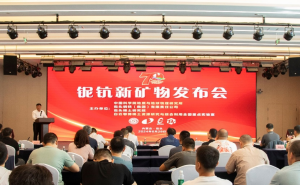
Niobium and Scandium new mineral conference site
(Photo by Baotou Research Institute of Rare Earth)
|
|
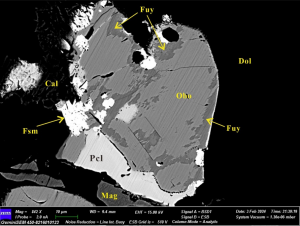
Backscattered electron image of fuyuanite (Fuy)
associated with oboniobite (Obo),
pyrochlore (Pcl), fersmite (Fsm),
magnetite (Mag), calcite (Cal),
and dolomite (Dol). (Image by FAN's Group)
|
2. Project Name: Geological Risk Prevention and Optimal Site Selection for Major Projects
Principal Investigator: QI Shengwen
Main Content:
The site selection for major projects must address the critical challenge of geological risks arising from multi-sphere dynamic coupling in project-disturbed areas. The research team has focused on resolving key scientific and technological issues related to geological risk prevention and optimal site selection for major projects. In 2024, the team achieved significant milestones: i) six related SCI papers, including four in top-tier Nature Index (NI) journals and one in an authoritative IGG journal, ii) eight invention patents were authorized (five in China and three internationally), and iii) A national-level consultation report was completed, and a new standard for site selection was developed and implemented. These efforts culminated in a systematic framework for geological risk assessment and engineering site optimization: "Multidimensional acquisition of regional geological body structure parameters -> Multiscale characterization of rock mass dynamic disaster risk -> Multilevel evaluation of engineering site suitability" has been formed:
1) A quantitative evaluation index has been proposed to quantify the connectivity of structural planes within engineering geological bodies;(link)
2) The study uncovered the mechanism of structural plane expansion and permeability alteration under strong stress disturbances, including those induced by internal and external Earth dynamics and engineering activities;
3) A model was constructed to simulate the long-term coupling effects of internal and external Earth dynamics with major projects, providing a predictive framework for potential disaster scenarios. Advanced technologies were developed for geological risk zoning and the classification and optimization of major project sites.
The research outcomes directly contribute to improving geological risk prevention for major projects and promote local disaster prevention and reduction efforts. Furthermore, the development and implementation of the engineering site-selection optimization standard mark a significant step towards standardizing methodologies in this domain, ensuring broader applicability and consistency in future engineering projects.
3. Project Name: Evolution of the Earth's Interior and Its Coupling with Surface Environments
Principal Investigator: HOU Yifei
Main Content:
The Earth's interior plays a dominant role in driving the functioning of the entire Earth system, influencing the dynamics of external spheres. Investigating the coupling mechanisms between the Earth's internal and external spheres represents a significant breakthrough in Earth system science. True polar wander (TPW) serves as a bridge for studying these interactions, as it describes the rotation of the Earth's crust-mantle system relative to the liquid outer core due to the redistribution of mass within the Earth. This phenomenon reflects the evolutionary history of the Earth's interior and its surface tectonic plates.
To gain a deeper understanding of this process, the research team identified the oscillatory true polar wander that occurred during the Late Jurassic-Early Cretaceous in the Yanshan tectonic belt, located along the northern margin of the North China Craton. By combining paleomagnetism data with precise chronological analyzes. Team discovered that this TPW event altered the climatic zone of the North China Craton, affected the changes in the surface environment, and played a key role in the development of the famous Yanliao and Jehol biotas. To further clarify the dynamics of true polar wander, the team successfully developed a self-consistent numerical model through three-dimensional simulations. This model reproduced structures similar to the large-low-shear-velocity provinces (LLSVPs) and the circum-Pacific subduction zones, enabling a detailed analysis of the long-term spatiotemporal evolution of LLSVPs. The findings found that LLSVPs are likely thermochemical anomalies, which supports their long-term stability. This stability helps anchor the Earth's rotation axis, providing a mechanism for the occurrence of oscillatory true polar wander.
These achievements provide critical insights into the multi-sphere interaction of the Earth system, providing key evidence and explanations for the mechanisms underlying true polar wander and its environmental and biological impacts. Both of these works were published in the top-tier international journal Nature Communications, where the observations on true polar wander were selected as a featured article by the editor-in-chief.
4. Project Name: Chang'e Mission Sample-returns Reveal the Moon's Enduring Vitality
Principal Investigator: ZHANG Qian
Main Content:
Basaltic volcanic activity is a symbol of the Moon's intrinsic "vitality" and its distribution shows a distinct "bipartite" pattern between the near and far sides of the Moon. Studying the duration of lunar volcanic activity is crucial for constructing a thermal evolution model of the Moon. Two key scientific questions remain regarding the Moon's intrinsic "vitality": whether volcanic activity younger than the 2-billion-year-old basalts from the Chang'e-5 mission exists and how long volcanic activity persisted on the Moon far side ? The team, based on the samples from the Chang'e-5 mission and the newly returned samples from the far side of the Moon by the Chang'e-6 mission. The research team carried out in-situ micro-isotopic and chronological analysis, and developed advanced testing technologies. The team achieved the following results:
1) Sulfur isotopes have been innovatively proposed and validated as a key indicator to distinguish volcanic origin glass beads, enriched in light sulfur isotopes, from impact origin glass beads, enriched in heavy sulfur isotopes. By applying this method, three volcanic glass beads were identified within just 3 grams of lunar soil from Chang'e-5 samples. U-Pb dating determined their formation age to be approx. 123±15 million years ago, demonstrating that small-scale volcanic activity persisted on the near side of the Moon until about 120 million years ago.(link1)
2) Two episodes of volcanic activity, occurring 4.2 billion years ago and 2.8 billion years ago, were discovered in the sampling area of Chang'e-6 and its vicinity. These findings indicate that volcanic activity on the far side of the Moon lasted at least 1.4 billion years. Further analysis revealed that the lunar mantle source region was enriched in KREEP material 4.2 billion years ago but was highly depleted 2.8 billion years ago. This suggests that the thickness of the lunar crust significantly influenced the sparse distribution of basaltic volcanic activity on the far side of the Moon.(link2)
3) The team addressed matrix effects in the ion probe analysis of glass U-Pb-Si-O isotopes by developing a glass standard similar in composition to the high-iron-content lunar soil samples from Chang'e-5. Additionally, they established a multi-standard joint correction method for U-Pb isotopes, ensuring more precise and reliable results.
|
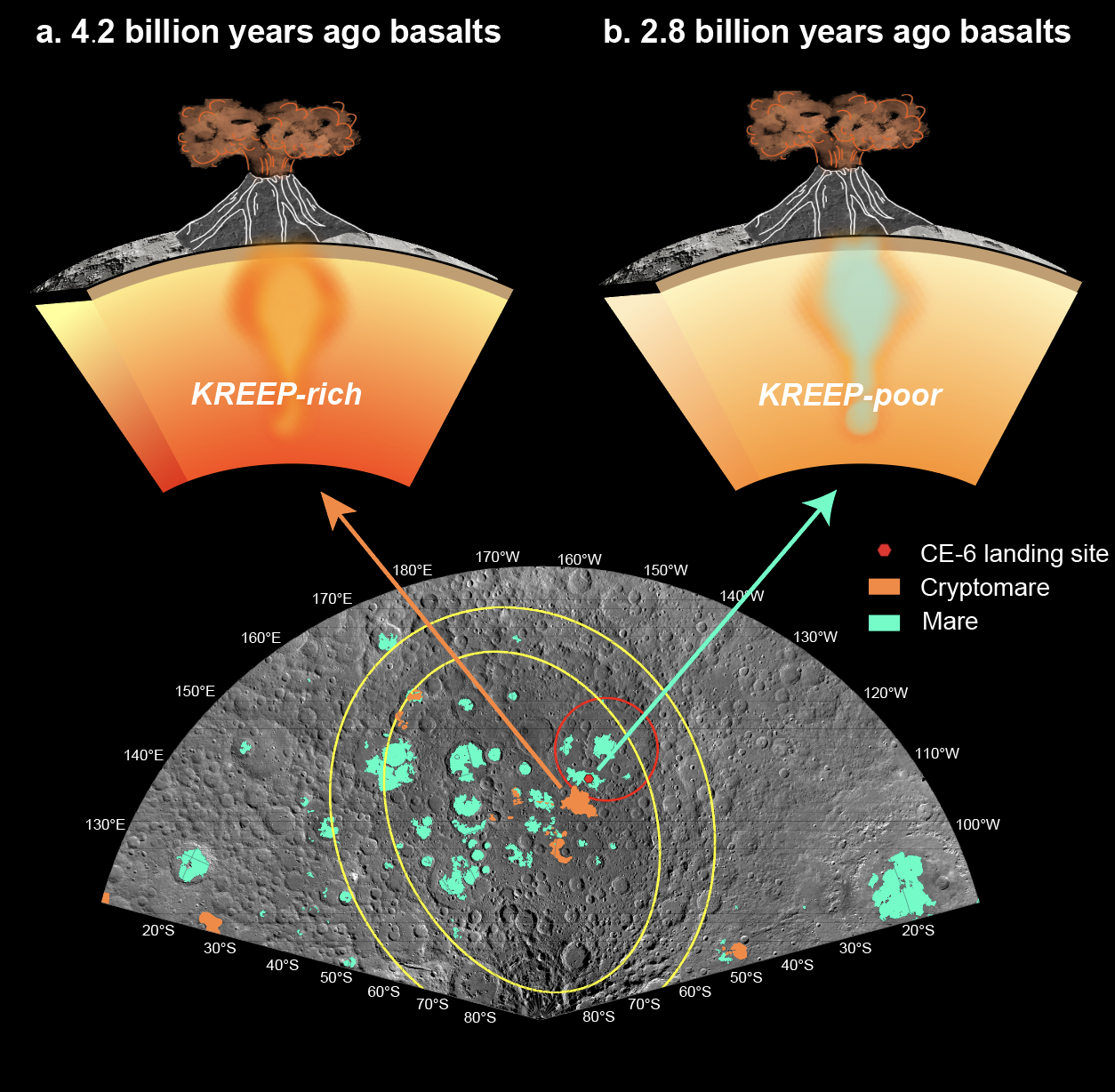
Distribution of distinct volcanic episodes
on the Moon's farside. The remote sensing
image highlights the Chang'e-6 landing site
along with nearby mare and cryptomare
basaltic units. (Image credit: YANG Muhan)
|
|

Meteorites impaction and volcanic eruption
producing glass beads on the Moon.
(Illustration by T. Zhang & Y. Wang)
|
5. Project Name: The 100,000-Year Evolutionary History of East Asian Rice from Wild to Domesticated
Principal Investigator: ZHANG Jianping
Main Content:
Rice, as one of the major food crops in the world, not only sustains one-third of the global population but also plays an important role in the formation and development of Chinese civilization. The domestication of rice and the origin of rice agriculture are significant scientific questions that have long attracted attention across many fields, including geology, archaeology, agronomy, and biology. In this study, the research team systematically studied phytoliths from modern wild and domesticated rice, establishing for the first time a clear relationship between the morphology of bulliform cell fan-shaped phytoliths and the degree of rice domestication. The team also proposed quantitative standards for identifying wild and domesticated rice using phytoliths.
By examining the phytoliths and performing high-precision dating of archaeological strata and natural sections from key sites of the Shangshan Culture in Zhejiang, the study revealed the complete process of the origin of East Asian rice agriculture. Wild rice was distributed in the lower reaches of the Yangtze River approx. 100,000 years ago. Around 24,000 years ago, humans began to gather and utilize wild rice. By around 13,000 years ago, wild rice cultivation had commenced, and by 11,000 years ago, domesticated rice appeared, marking the beginning of rice agriculture in East Asia.
This study not only provides a comprehensive evolutionary framework for the transition of wild rice from gathering to domestication but also reaffirms China as the birthplace of rice agriculture. Furthermore, it lays a critical foundation for exploring the relationship between rice domestication and the origin and development of Chinese civilization. The study's significance has been widely recognized, with its findings selected as hot and highly cited papers (HCP) by Web of Science. The results have also been included in the national textbook "Geography", and widely reported by more than 60 media outlets, including CCTV News Channel, Xinhua News Agency, and People's Daily. With total online exposure exceeding 8 million views, the study has garnered great attention in both the academic and social spheres.(link1, link2)
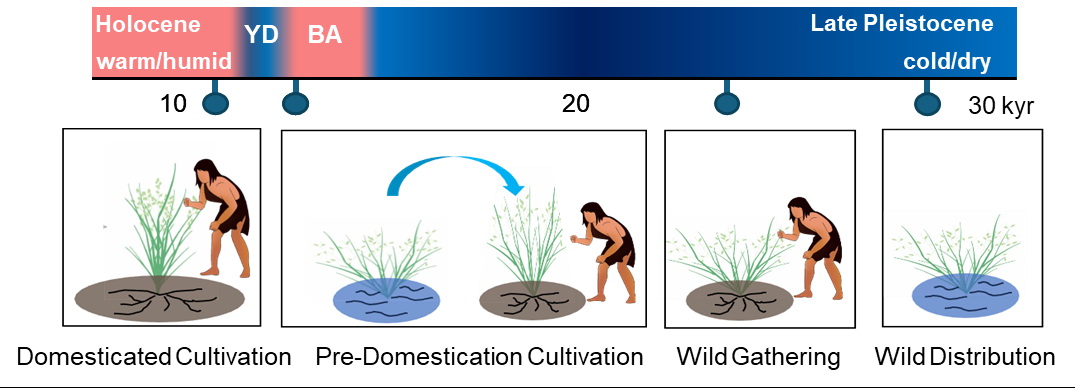
Conceptual model from rice exploitation to domestication since 30 kyr BP in the Lower Yangtze River region. (Images provided by ZHANG Jianping)
6. Project Name: Energy and Matter Transport Processes in the Magnetosphere-Ionosphere Coupling System
Principal Investigator: GAO Jiawei
Main Content:
The planets in the solar system exhibit vastly different space environment characteristics, ranging from Jupiter, with its strong intrinsic magnetic field, to Earth and Mercury, which have weaker dipole magnetic fields, and to unmagnetized planets like Mars which lack intrinsic magnetic fields. The solar wind transfers matter and energy to the planetary space environment through the magnetosphere-ionosphere coupling system of planets, thereby influencing their habitability and climate evolution. Utilizing satellite data analysis, independent data analysis methods, and computer simulations, a research team focused on energy and matter transport processes in the magnetosphere-ionosphere coupling system of planets through comparative planetary research approaches. This year, they achieved several important discoveries:
1) For the first time, it was revealed that the ionospheric currents of Mars are driven by both the solar wind and the atmospheric neutral wind, providing crucial observational evidence for the electrodynamics of the induced magnetosphere in non-magnetized planets. This work, published as a featured article by Nature Communications, was highly praised by the editor for clarifying the current system in the magnetosphere-ionosphere coupling on non-magnetized planets.
2) Using data from the Juno spacecraft, the cusp region at the magnetopause was directly observed for the first time, revealing its plasma characteristics and its connection to Jupiter's magnetotail and auroras. This work, was also featured in Nature Communications, and was commended by the editor for laying a theoretical foundation for further exploration of Jupiter's magnetospheric dynamics.
3) The team revealed, for the first time, the asymmetry in the plasma distribution within the magnetotail current sheets of Mercury and Jupiter. Additionally, they discovered a tailward escaping high-energy Martian atmospheric ion flow in the magnetotail current sheet of Mars. These findings expand the understanding of planetary magnetosheath wave phenomena and provide new insights into planetary magnetotail dynamics.
These research findings have significantly advanced the understanding of energy and matter transport in the space environments of solar system planets. They provide vital data support and theoretical insights for future planetary exploration missions, with broad academic impact and practical application value.
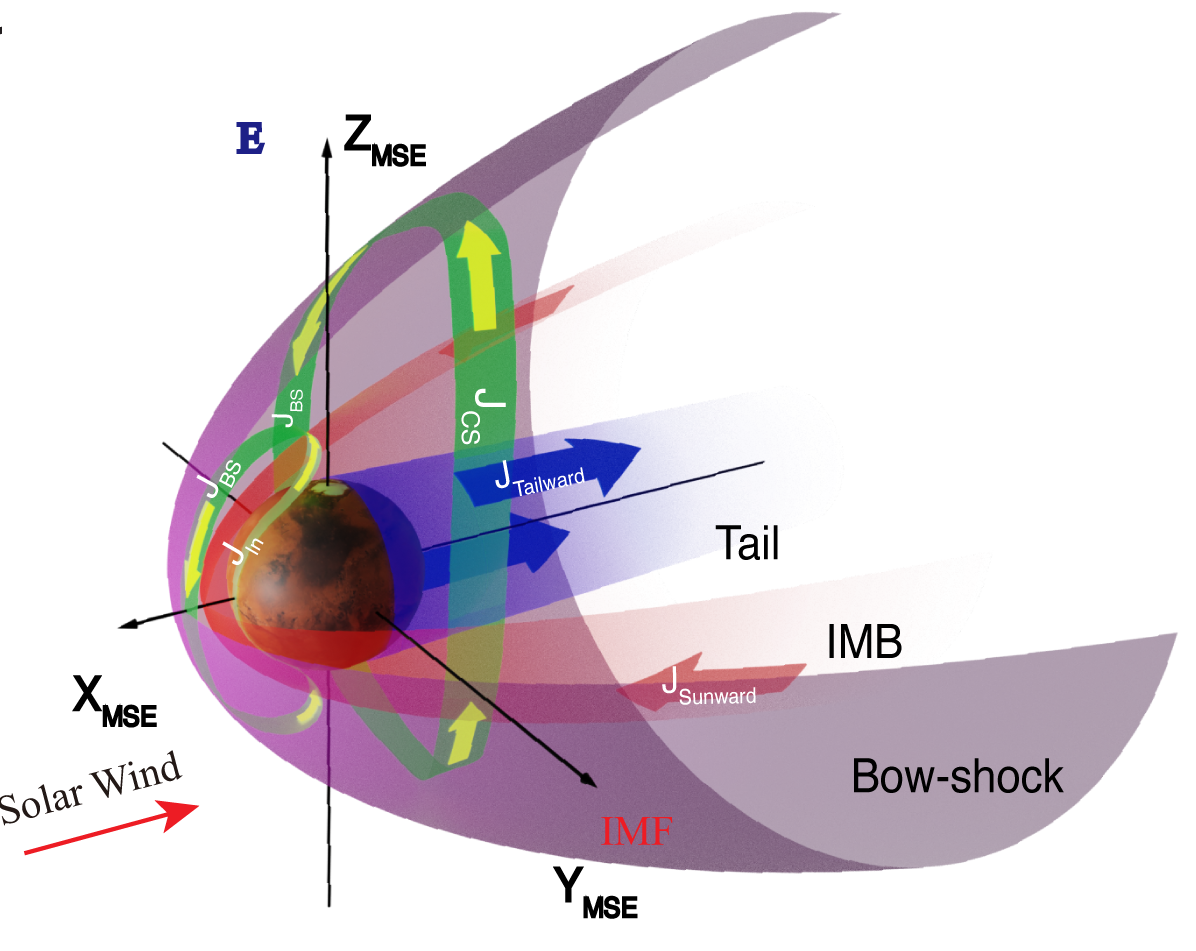
Diagram of the current systems in the induced magnetosphere. (Image by GAO Jiawei's Group)
7. Project Name: Research on Continental Lithosphere Deformation
Principal Investigator: CAO Zebin
Main Content:
The classical theory of plate tectonics posits that the interior of continental plates, particularly cratonic regions, are rigid and less susceptible to deformability. However, extensive geological and geophysical data indicate that large-scale tectonic deformation does occur within continental plates, and the mechanisms driving this phenomenon remain a matter of considerable debate. Adopting an Earth system science approach, the team has systematically studied intracontinental deformation during different periods in western North America, North China, and the Tarim region in China. Their work integrates multidisciplinary and multi-source observational data with the principles of geodynamics.
The study's results show that, in intracontinental regions located far from plate boundaries, the properties of the lithospheric mantle play a critical role in controlling the deformation processes of the overlying crust. Interaction between mantle flow and cratonic lithosphere, along with deep processes such as subduction, exhumation of adjacent continents, and mantle plume upwelling, significantly alter the mechanical state and physicochemical properties of the continental lithosphere. Furthermore, the systematic study demonstrates that the various layers of the solid Earth are intricately connected, and deep geodynamic processes exert a significant impact on shallow crustal deformation.
This research has garnered widespread attention from the academic community both domestically and internationally. Notably, the study of intracontinental deformation in western North America was featured on the official website of the US EarthScope Consortium. Additionally, members of the research team were invited to deliver a special presentation on their research findings at the Department of Earth, Atmospheric, and Planetary Sciences at Purdue University.
The findings provide valuable new insights into intraplate earthquakes and volcanic activity, craton destruction, and the evolution of intraplate basins. They also offer a novel perspective on the evolution of the continental lithosphere and processes such as mineralization and resource accumulation within continents. Moreover, the results contribute a solid scientific basis for efforts in earthquake prevention and disaster reduction.
8. Project Name: Himalayan Orogeny and Lithium Mineralization Theory
Principal Investigator: LIU Xiaochi
Main Content:
The Himalayas, the highest mountain range on Earth, have a formation and evolutionary history that remains a key focus of Earth science research. Through systematic scientific expeditions and studies in the Himalayan region, a research team has demonstrated that the Himalayas possess a unique geological setting for lithium mineralization, with its uplift process closely linked to the formation of the critical metal lithium.
Situated within the Neo-Tethyan metallogenic domain, the Himalayas have a geological history influenced by the long-standing presence of the Tethys Ocean in the low-latitude region. This has resulted in extensive deposits of lithium-rich clay minerals, making the sedimentary rocks in the Himalayan region generally enriched in lithium. During the collision of the Indian and Eurasian continents, the South Tibetan Detachment System, the largest detachment tectonic system in the world, was formed. This tectonic system facilitated the rapid uplift of the Himalayas, giving rise to the mountain range as we know it. Simultaneously, the lithium-rich source region underwent prolonged high temperature to ultrahigh-temperature metamorphism and partial melting. Magmas migrated along the detachment system, and under the influence of tectonic differential stress, lithium-rich melts were extracted, culminating in lithium mineralization.
The team's results have been published in journals such as Nature Communications and Earth and Planetary Science Letters, with a total of 39 citations to date. This year, the team organized three special issues on Himalayan orogeny and rare metal mineralization in journals such as Elements and Acta Petrologica Sinica. Guided by their novel mineralization theory, the team conducted surveys along the South Tibetan Detachment System and identified nine new lithium mineralization sites in the Himalayas, extending over 1,500 km from east to west. These discoveries have led to the preliminary establishment of the Neo-Tethyan giant lithium mineralization belt. (link)
9. Project Name: Research on Inner Core Oscillation and Small-Scale Structures at the Core-Mantle Boundary
Principal Investigator:WANG Wei
Main Content:
Small-scale structures are widespread within the Earth's interior and provide valuable insights into the Earth's formation and evolutionary dynamics. The research team systematically investigated these small-scale structures using seismic precursors, coda waves, and direct waveforms, revealing that the Earth's inner core exhibits an oscillatory mode of differential rotation. Additionally, they identified the distribution of small-scale structures at the base of the lower mantle and within the inner core.
Small-scale structures within the Earth generate intrinsic inner core scattering waves. Leveraging this characteristic, Wang et al. (2024) analyzed inner core scattering waves from South Sandwich Islands repeating earthquakes recorded by the North American seismic array between 1990 and 2023 to detect temporal changes in the inner core. Their findings show that the rotation speed of the inner core varies over time: between 2003 and 2008, the inner core exhibited super-rotation with an angular velocity greater than that of the Earth, whereas from 2008 to 2023, it entered a state of sub-rotation with an angular velocity lower than that of the Earth. These results confirm that the inner core undergoes an oscillatory mode of differential rotation. The study further suggests that beyond previously proposed mechanisms such as gravitational coupling between the mantle and the inner core, more complex mechanisms may be driving the differential motion of the inner core. Zhang et al. (2024) and Guan et al. (2024) utilized inner core reflected waves and PKP precursors, respectively, to detect the small-scale undulations at the inner core boundary and the presence of small-scale scatterers at the base of the lower mantle.
This research has garnered widespread attention from the academic community. Notably, the work on inner core oscillation has been prominently covered by domestic and international media outlets, including Science and Technology Daily, phys.org, and CNN. (link)